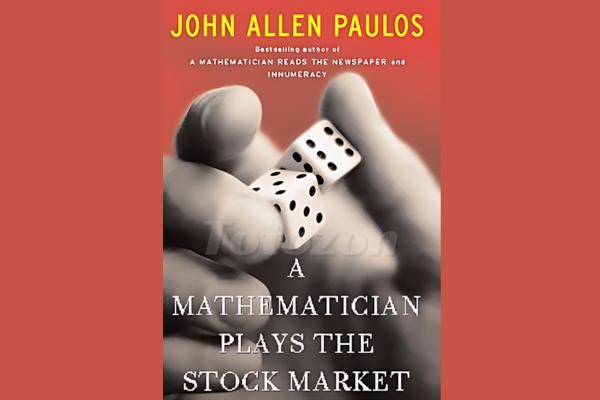-
×
 The Naked Eye: Raw Data Analytics with Edgar Torres - Raw Data Analytics
1 × $8.00
The Naked Eye: Raw Data Analytics with Edgar Torres - Raw Data Analytics
1 × $8.00 -
×
 The Trading Blueprint with Brad Goh - The Trading Geek
1 × $5.00
The Trading Blueprint with Brad Goh - The Trading Geek
1 × $5.00 -
×
 How To Read The Market Professionally with TradeSmart
1 × $27.00
How To Read The Market Professionally with TradeSmart
1 × $27.00 -
×
 Order flow self-study training program with iMFtracker
1 × $10.00
Order flow self-study training program with iMFtracker
1 × $10.00 -
×
 Algo Trading Masterclass with Ali Casey - StatOasis
1 × $23.00
Algo Trading Masterclass with Ali Casey - StatOasis
1 × $23.00
A Mathematician Plays The Stock Market with John Allen Paulos
$6.00
File Size: Coming soon!
Delivery Time: 1–12 hours
Media Type: Online Course
A Mathematician Plays The Stock Market with John Allen Paulos
Introduction to John Allen Paulos
John Allen Paulos is a renowned mathematician and author known for his ability to simplify complex mathematical concepts for a general audience. His book, “A Mathematician Plays The Stock Market,” delves into the world of investing, exploring how mathematical principles can provide insights into stock market behaviors.
Why Mathematics in the Stock Market?
The Role of Mathematics
Mathematics plays a crucial role in the stock market, helping traders and investors make informed decisions based on quantitative data. From probability to statistical analysis, math provides tools for predicting market trends and assessing risks.
Paulos’s Perspective
Paulos approaches the stock market with a mathematician’s eye, highlighting the importance of logical reasoning and statistical thinking in making investment decisions.
Key Themes in “A Mathematician Plays The Stock Market”
Understanding Market Volatility
Market volatility is a key theme in Paulos’s book. He explains how mathematical models can help predict and manage the fluctuations in stock prices.
The Concept of Randomness
Paulos emphasizes the role of randomness in the stock market. He uses mathematical concepts to illustrate how unpredictable market movements can be and the implications for investors.
Behavioral Finance
The book also touches on behavioral finance, exploring how psychological factors influence investment decisions and market outcomes.
Applying Mathematical Principles
Probability and Statistics
Probability and statistics are essential tools for any investor. Paulos explains how these concepts can be used to evaluate the likelihood of various market scenarios and make data-driven decisions.
The Law of Large Numbers
The Law of Large Numbers is another important principle discussed in the book. This law suggests that the average of the results obtained from a large number of trials should be close to the expected value, which can be applied to understand long-term market trends.
Risk Assessment
Mathematical models are invaluable for assessing risk. Paulos discusses various risk management strategies that rely on mathematical principles to minimize potential losses.
Practical Insights from Paulos’s Experience
The Dot-Com Bubble
Paulos provides a personal account of his experiences during the dot-com bubble, offering lessons on the dangers of speculative investing and the importance of fundamental analysis.
Lessons on Diversification
Diversification is a critical strategy highlighted in the book. Paulos explains how spreading investments across different assets can reduce risk and improve returns.
The Importance of Patience
Patience is a virtue in investing. Paulos underscores the importance of a long-term perspective, avoiding the temptation to react impulsively to short-term market movements.
Common Misconceptions in Investing
Overconfidence Bias
Paulos addresses the overconfidence bias, where investors overestimate their ability to predict market movements, leading to poor decision-making.
The Fallacy of Patterns
The book debunks the fallacy of patterns, cautioning against seeing trends where none exist. Paulos uses mathematical reasoning to explain why such patterns often lead to misguided investments.
Enhancing Your Investment Strategy
Developing a Mathematical Mindset
Developing a mathematical mindset can enhance your investment strategy. Paulos encourages readers to think critically and quantitatively about their investment choices.
Utilizing Technology
With advancements in technology, investors can leverage mathematical software and tools to analyze market data and make informed decisions.
Continuous Learning
Continuous learning is essential in the ever-evolving world of finance. Paulos advocates for staying updated with the latest mathematical models and financial theories to refine your investment approach.
Conclusion
“A Mathematician Plays The Stock Market” by John Allen Paulos offers a unique perspective on investing, blending mathematical principles with practical insights. By understanding and applying these concepts, investors can improve their decision-making processes and achieve better market outcomes.
FAQs
What is the main focus of John Allen Paulos’s book?
The main focus of the book is to explore how mathematical principles can provide insights into stock market behaviors and improve investment decisions.
How does mathematics help in investing?
Mathematics helps in investing by providing tools for predicting market trends, assessing risks, and making data-driven decisions.
What lessons does Paulos offer from his experience during the dot-com bubble?
Paulos highlights the dangers of speculative investing, the importance of fundamental analysis, and the value of maintaining a long-term perspective.
Why is diversification important in investing?
Diversification reduces risk by spreading investments across different assets, which can lead to more stable returns.
How can investors develop a mathematical mindset?
Investors can develop a mathematical mindset by thinking critically and quantitatively about their investment choices, continuously learning, and leveraging mathematical tools and models.
Be the first to review “A Mathematician Plays The Stock Market with John Allen Paulos” Cancel reply
You must be logged in to post a review.
Related products
Forex Trading
Forex Trading
Forex Trading
Forex Trading
Forex Trading
Forex Trading
Forex Trading
Forex Trading
Forex Trading
The Complete Guide to Multiple Time Frame Analysis & Reading Price Action with Aiman Almansoori
Forex Trading
Forex Trading



















Reviews
There are no reviews yet.